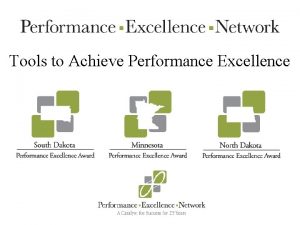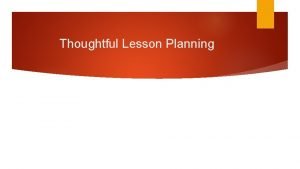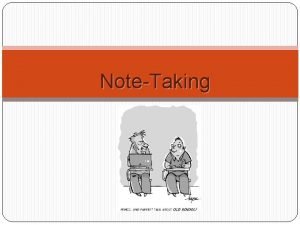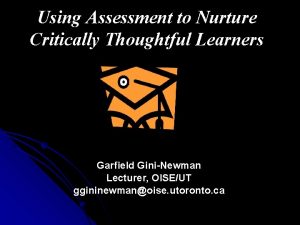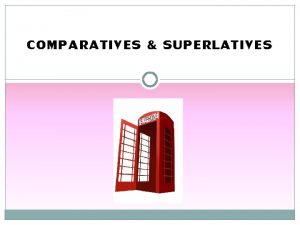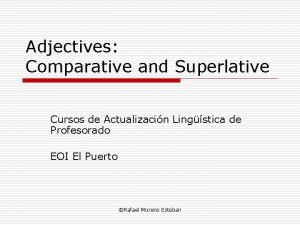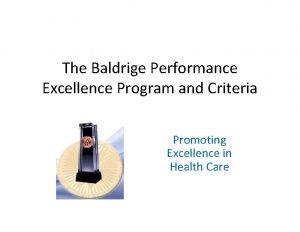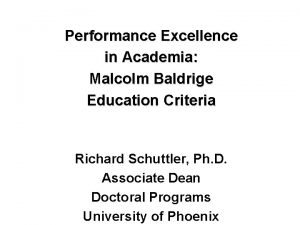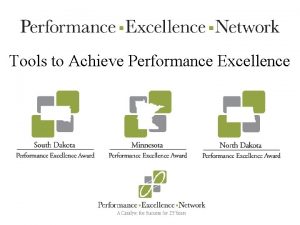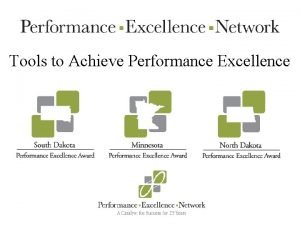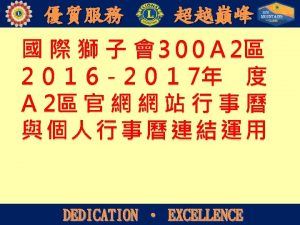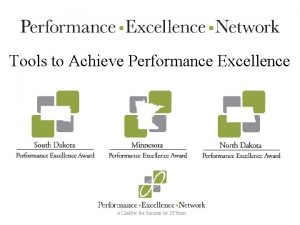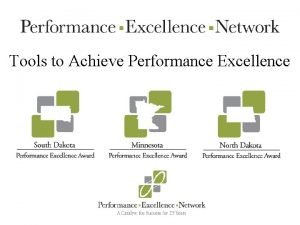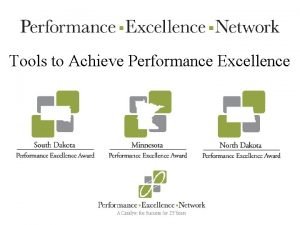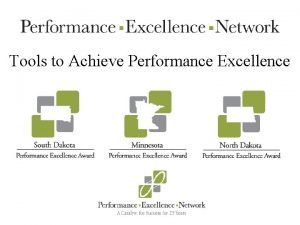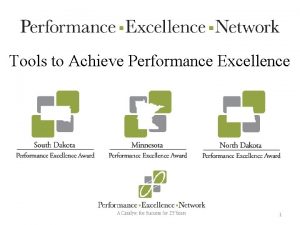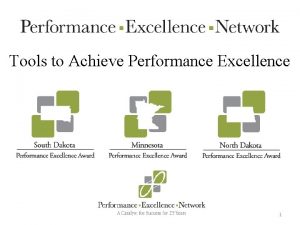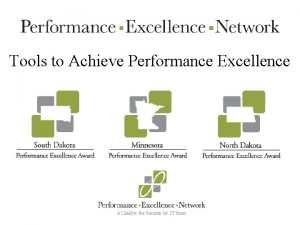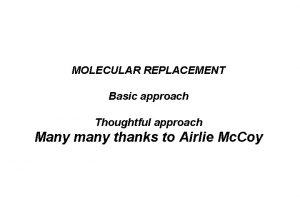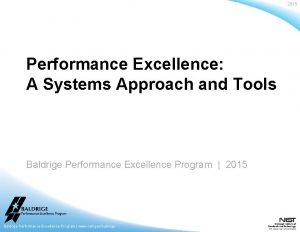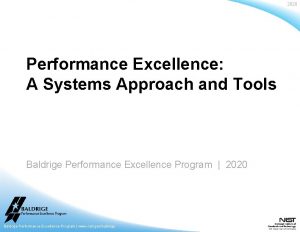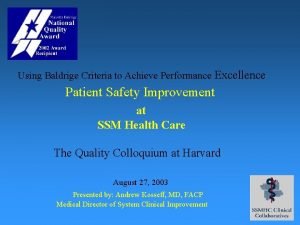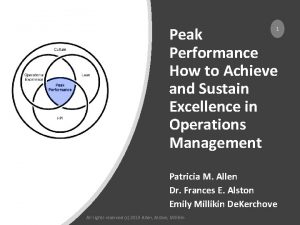Tools to Achieve Performance Excellence A Thoughtful Approach





















- Slides: 21

Tools to Achieve Performance Excellence

A Thoughtful Approach to Root Cause Analysis Andrew Kirsch Master Black Belt Enterprise Excellence ECOLAB

Two Philosophical Assumptions We all experience a shared Reality All effects are caused

Three Imperfect Definitions • Effect - A change in a state of being that results when something is done, or happens, or does not happen. • Cause – Something that contributes to producing an effect • Root Cause – One or a few of the most fundamental of a chain of causes that product an effect

5 Why’s and the Washington Monument Problem: Washington Monument required frequent, very expensive repairs. 1. Why? Frequent washing was damaging the monument. 2. Why did it need to be washed so much? Pigeon droppings 3. Why were the pigeons on the monument? To eat the spiders 4. Why were there spiders on the monument? To eat the insects 5. Why were the insects there?

A Template for 5 Why Analysis Effect of Interest: 1. Why? 2. Why? 3. Why? 4. Why? 5. Why? Tips for Use: 1. There is nothing magic about 5, but push yourself to go further than 1 or 2 2. At some point you may find yourself going from the specific to the general (poor communication, political gridlock, lack of motivation) - back up and try to be more specific

Cause and Effect Diagram (Also called Fishbone or Ishikawa Diagram) Categories of Causes Effect of Interest Represents the relationship between an effect (problem) and its potential causes where causes are organized by categories

Cause and Effect Diagram • Why - Use of categories ensure a full range of potential causes have been considered • Overcome the “theme effect” by allowing the group to see the categories into which their ideas fall and dig deeper on those with fewer items • How – Decide on a set of major categories before starting to brainstorm causes • The traditional categories for manufacturing are personnel, environment, machines, materials, methods, measurements • For non-manufacturing use, might use the 4 Ps: Place, Procedures, People, Policies

Blending Fishbone and 5 Why Methods The 5 Why method is often used with a Cause and Effect Diagram to drill down to a root cause Effect: Cost of maintaining test kits for field employees too high 1. Why? Must frequently replace reagents in the kits 2. Why? The reagents are past expiration date 3. Why? The shelf life of many of the reagents are a year or less Effect: Same 1. Why? Have to pay a high price for the reagents in the quantities needed 2. Why? xxxxxxx 3. Why? xxxxxxxxxx 4. Why? xxxxxxxxx 5. Why? xxxxxxx 4. Why? At the time that the shelf lives were determined, the software for recording the official shelf life only had two choices in the pulldown menu – 6 months and 12 months! Corrective Action = Qualify and document a longer shelf life where possible

Limitations of a Simplistic Analysis 1. An effect may require two or more causes to occur in the same place and time 2. The analysis may be limited by the current level of knowledge 3. The analysis may be based on conventional wisdom or restricted by prejudice 4. The root cause may not be the easiest to fix 5. An effect may be part of a system “loop”

A Template for Two or More Causes per Level (per Why) Effect 1 st Level Why 2 nd Level Why 3 rd Level Why Cause 1. 1. 2 Cause 1. 2. 1 Cause 1. 2. 2 Cause 2. 1. 1 Cause 2. 2. 2 Cause 2. 2. 1 Cause 2. 2. 2 Cause 3. 1. 2 Cause 3. 2. 1 Cause 3. 2. 2

Two or More Causes per Level (per Why) Effect 1 st Level Why 2 nd Level Why 3 rd Level Why Worker hurt his hand shoulder by slipping on a wet floor, while walking through an area not intended for foot traffic Cause 1 The floor was wet Cause 1. 1 The drain was not working Cause 1. 1. 1 Plugged Cause 1. 2 The vessel had to be rinsed Cause 1. 2. 1 SOP requires Cause 2. 1 The shoes were 5 years old Cause 2. 1. 1 Cause 2. 2 The shoes hadn’t been replaced Cause 2. 2. 1 Thought ok Cause 2 The worker’s shoes had poor tread Cause 3. 1 Alternate The worker chose to route takes longer go through this area Cause 3. 2 No barrier to prevent Cause 1. 1. 2 Not checked Cause 1. 2. 2 Cause 2. 2. 2 Busy Cause 3. 1. 1 Plant design Cause 3. 1. 2 Cause 3. 2. 1 Not expected Cause 3. 2. 2

Considerations beyond Root Cause • Tradeoffs • Span of Influence or Control • Legality, Propriety, Respectfulness

Two or More Causes: Reconsidering the Washington Monument Problem: Washington Monument repairs. 1. Why? Frequent washing was damaging the monument. 2. Why did it need to be washed so much? Pigeon droppings 3. Why? Pigeons AND a food source (spiders) 4. Why? A nearby population of pigeons Spiders AND a food source (insects) 5. Why? A nearby population of spiders A nearby population of insects

5 Why for an Act of Gang Violence + Member of Gang A Hurt by B Gang B Wants Revenge + Gang A Feels Violated + + Gang B Feels Violated + Gang A Wants Revenge Member of Gang B Hurt by A +

Role of Evidence/Data • Makes all the difference between “conventional wisdom” and sound analysis – A single instance is not strong proof of root cause • Each link in the chain of causes should be verified with evidence/data – Physical scientific studies (e. g. chemical analysis) – Statistical studies (e. g. clinical trials) – Behavioral studies (e. g. Hawthorne effect) – Historical data review (e. g. drunk driving) – Is/Is Not analysis

Is/Is Not Analysis • Consider the what, where, when, extent of the problem/deviation: – What specific object has the problem/deviation? – What is the nature of the problem/deviation? – What similar object could have the problem/deviation but does not? – What other problems/deviations might reasonably be observed but are not? • Test if possible causes against the is and is not facts to rule out some, judge likelihood IS IS NOT

Boiling it down … 1. Start with a fishbone diagram to enlarge your view of possible causes 2. Use the 5 Why approach to go deep – – – Be open to multiple causes at each level Use simple (linear) 5 Why when possible Be open to a system loop 3. Look for data to support the chain of causes 4. Decide on the root cause(s) – – Give preference to prevention at that cause Factor in tradeoffs, span of influence, etc. as appropriate

Summary of Tools Discussed • Fishbone Diagram • 5 Why (Simple and Multiple Cause) • Systems Thinking (the Loop) – See Peter Senge, “The Fifth Discipline” • Is/Is Not Analysis – See Charles Kepner and Benjamin Tregoe, “The New Rational Manager”

QUESTIONS?

 How to achieve performance excellence
How to achieve performance excellence Thoughtful thursday morning message
Thoughtful thursday morning message Thoughtful literacy
Thoughtful literacy Thoughtful learning
Thoughtful learning Thoughtful notes
Thoughtful notes Comparative and s
Comparative and s Critically thoughful
Critically thoughful Romeo juliet introduction
Romeo juliet introduction Manycomparative and superlative
Manycomparative and superlative Thoughtful learning
Thoughtful learning Thoughtful comparative and superlative
Thoughtful comparative and superlative Frosts simple style is deceptive and a thoughtful reader
Frosts simple style is deceptive and a thoughtful reader Baldrige performance excellence program
Baldrige performance excellence program Tppen
Tppen Malcolm baldrige criteria for performance excellence
Malcolm baldrige criteria for performance excellence Malcolm baldrige criteria for performance excellence
Malcolm baldrige criteria for performance excellence Datagram switching and virtual circuit switching
Datagram switching and virtual circuit switching Theoretical models of counseling
Theoretical models of counseling Shower approach in international marketing
Shower approach in international marketing Avoidance
Avoidance Bandura's reciprocal determinism
Bandura's reciprocal determinism Research approach definition
Research approach definition
